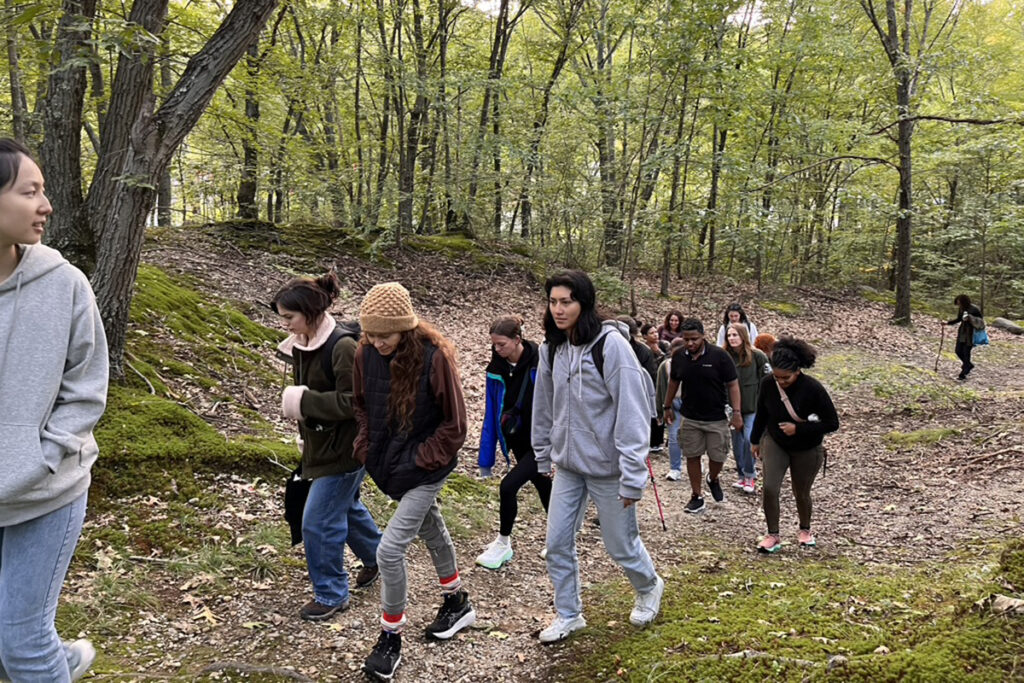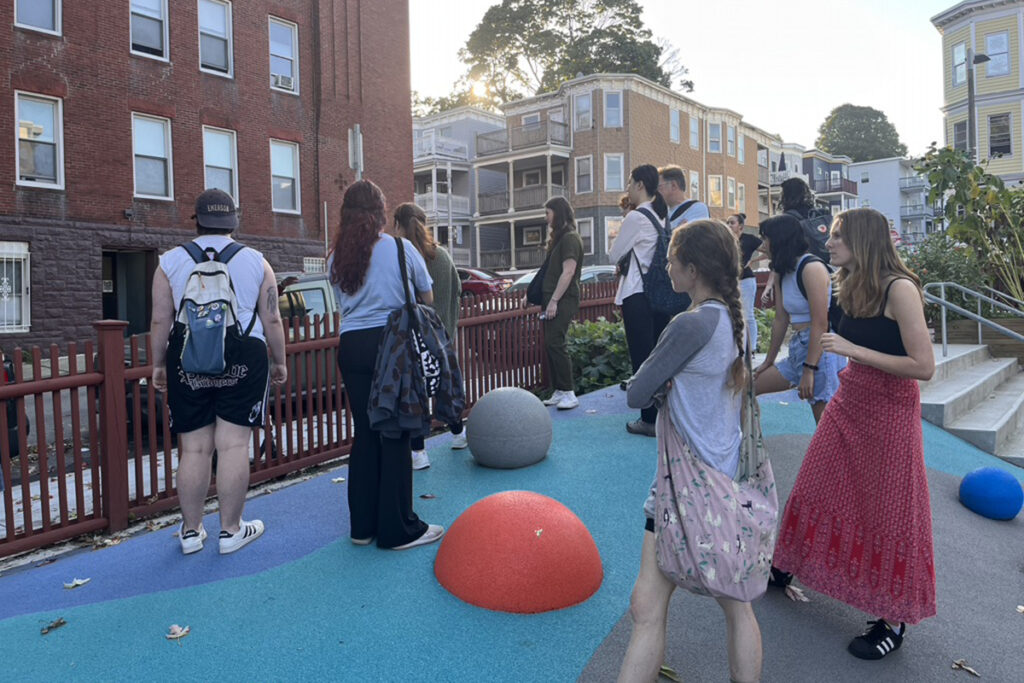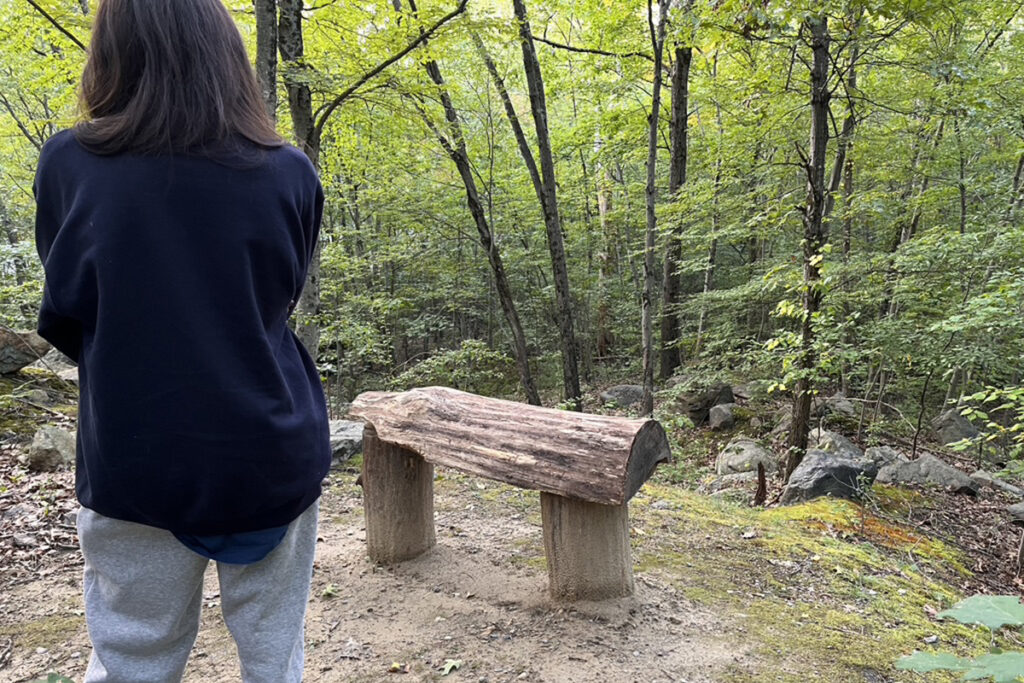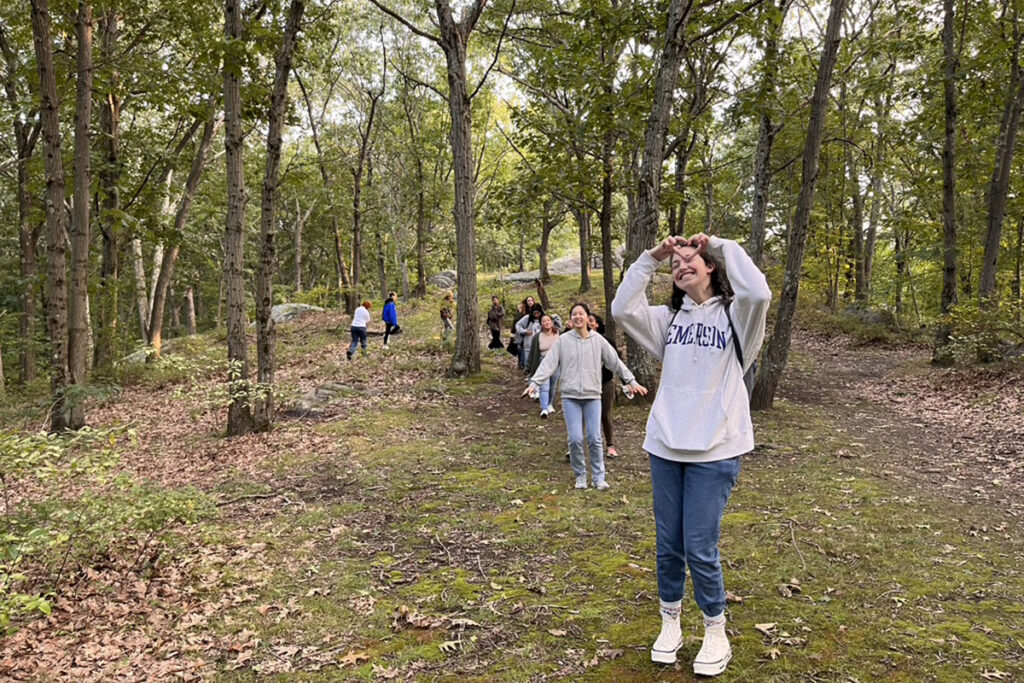New Emerson ELab Studios Flipping the Script on Environmental Justice

When Gracie Rosenberg ’26 read the course description for Creative Expression for Climate Justice last spring, she knew she needed to get in.
The Media Arts Production major and aspiring documentary filmmaker saw an opportunity to put her technical skills and creativity to work in service of local environmental justice, and just as importantly, the chance to collaborate with a grassroots organization doing the work out in the community.
“Instead of being like, ‘I can make a little documentary about sea level rising,’ this is much more direct,” Rosenberg said. “And I’m personally someone who really believes major changes for things like climate justice happen on a super local, small scale.”
The course, a Social Impact Studio co-taught this fall by Visual & Media Arts (VMA) Associate Professor Paul Turano and affiliated faculty member Erin Trahan, is part of Transforming Narratives of Environmental Justice (TNEJ), a new Engagement Lab (ELab) initiative.
TNEJ is modeled on the successful Transforming Narratives of Gun Violence (TNGV), launched in 2021. The projects operate via Social Impact Studios – multidisciplinary courses in which students work collaboratively with community members and organizations to address critical social justice issues by telling stories that center the voices of those most directly affected.
“The environmental crisis needs different kinds of stories, because the stories of doom or ignorance that fills our media channels will simply not do,” said Professor Eric Gordon, Engagement Lab director. “We cannot hope to change the future unless we can imagine what that future looks like. And we at Emerson can’t imagine a just and viable future, unless we are working alongside those typically excluded from those narratives.”
Both initiatives will present a showcase of this semester’s work in two separate events at the Bordy Theater this week: Transforming Narratives of Gun Violence: Peace in Process will be held Tuesday, Dec. 12, 5:30 pm, and Transforming Narratives of Environmental Justice: Planting Futures, will take place Wednesday, Dec. 13, 5:30 pm.

Transforming Another Narrative
There are a lot of issues out there that are crying out for different stories and new solutions. But environmental justice – defined by the U.S. Environmental Protection Agency as “the fair treatment and meaningful involvement of all people regardless of race, color, national origin, or income with respect to the development, implementation, and enforcement of environmental laws, regulations, and policies” — lends itself to the Social Impact Studio format, and plays to Emerson’s strengths, said Professor Nejem Raheem, an environmental economist and ELab Senior Fellow.
“If we’re going to keep this Transforming Narratives thing going and look at both communication and policy in the context of some kind of environmental sphere, the environmental justice world is perfect for the kind of thinking that dominates at Emerson,” he said.
For Creative Expression for Climate Justice, Turano and Trahan partnered with two community organizations addressing environmental justice in Boston neighborhoods. The Fairmount Indigo CDC Collaborative (FICC) serves the predominately low- and moderate-income neighborhoods along the Fairmount commuter rail line, which runs from Boston’s South Station through Dorchester, Mattapan, and Hyde Park. Speak for the Trees advocates for Boston’s urban forestry.
At the start of the semester, everyone in the class – Emerson students and “learning partners” from the community orgs – worked on the same individual exercises meant to illuminate the connections between nature, individuals, and communities. For instance, the “You Tree,” encouraged participants to explore how nature and humans thrive and suffer from many of the same factors.
The students then split into teams with the community organizations to work on a creative project that was co-designed with the orgs and aimed at their constituents. The groups came up with a wide range of creative ways to tell the story of what an environmentally just future could look like: film, interactive websites, collage.
“Because Erin’s coming from a background of journalism and creative writing [and] I’m coming from a background of emerging media and film, we’re really bringing both of those areas of creative interest to the class and offering it as a range of options,” said Turano, praising the co-teaching method. “It allowed them to think about it beyond documentary film, which I think is sort of an initial assumption that the students can make.”

Documentary film was the first instinct of Rosenberg and her group. FICC wanted something that focused on the history of transportation and public transportation advocacy in Boston, that could be used to draw in new generations of potential advocates. They also wanted something that would appeal to and educate Fairmount line riders on what FICC does, Rosenberg said.
But the team soon realized that they couldn’t accomplish all the goals they had in the short time they had with a documentary, Rosenberg said. They landed on a social media campaign that would provide FICC with a range of assets – video, Instagram posts, etc. – they can use to reach younger audiences.
“Each of us have our own areas of expertise that we’re bringing, but we’re also encouraging and allowing the students to experiment and to really find a way to bring form to their very strong feelings about what’s going on in the world around them,” Trahan said.
‘Keeping the Conversation Going’
Arnaldo Pires was looking for volunteer opportunities for his girlfriend when he heard about FICC and their work along the Fairmount line corridor, where Pires lives. He took an advocacy training course through FICC and with his mother, headed to the State House in support of a bill to electrify Fairmount line trains, which currently run on diesel. Soon, he was invited to participate in Creative Expression for Climate Justice, where he works with students, faculty, and fellow community members and organizers to tell stories about the environment that impact his neighbors. As of this academic year, Pires and the other learning partners in Social Impact Studios can choose to earn credit or a small stipend for their participation.
Before he started volunteering with FICC, he had no idea that the trains ran on diesel, and never thought about the emissions they pumped into his neighborhood and others along the line. Most might notice the trash that accumulated in Uphams Corner due to a lack of bins (his individual project for the Emerson class was a neighborhood cleanup), but he wasn’t sure how many people with asthma realized how much poor air quality was affecting them.
It can be difficult to reach people, Pires said, even with stories that center them. In his Cape Verdean neighborhood, not everyone speaks or reads English, and even those who do are busy just living their lives. But Pires said he thinks the assets his team created will help elevate environmental issues in his neighbors’ consciousness.
“They keep the conversation going,” Pires said. “They get people to think that, ‘OK, well this didn’t come out of nowhere – someone made this, someone put this out there and somebody cares. And it looks like it’s kind of geared towards our area where we live, and it looks like someone’s fighting for us.’”

Challenges and Payoffs
Jon Honea, Associate Professor in the Marlboro Institute of Liberal Arts & Interdisciplinary Studies and an ecologist, is co-teaching another TNEJ Social Impact Studio this fall with Homa Sarabi, Director of Production Safety and Sustainability for the VMA Department, called Future Imaginaries: Unwritten Stories of Climate Change & Sustainability.
In Future Imaginaries, students worked alongside volunteers (primarily high school students) with GreenRoots, an environmental justice organization based in Chelsea, Mass., to produce films and an elementary-level activity book aimed at inspiring their community to get involved in countering environmental degradation.
Honea says it’s critical that these projects counter the “gloom and doom” narrative that says we aren’t doing enough to fight climate change and it may be too late to bother trying.
“People despair and they lose hope, and they think they can’t make a difference in these huge problems,” Honea said. “But there’s been a new perspective emerging that if we were to focus on what the future might look like if we started doing things, and provided hope for such a future, that might motivate participation in the action needed to get there.
“The task for our students, then, was to talk with people from Chelsea and identify what would a future Chelsea actually look like, one that benefitted the residents? And then the students’ job was to communicate that in some way.”
The co-design process that Social Impact Studios and the Transforming Narratives initiatives use is not without challenges.
For one thing, Raheem said, Emerson, like all colleges, operates as its “own little country” with its own schedules, bureaucracies, and ways of doing things that may be very different from how grassroots organizations work. Academic environments like Emerson’s also aren’t built around the kind of structures (co-teaching, field work) that best serve the Social Impact Studio model. Emerson students must cross distances – geographical and experiential – in order to meet their community partners where they live.
“I think that’s been one of the real values of the class, is helping expose the Emerson students to those challenges and helping them to recognize that it’s normal for it to be difficult, and we just have to persevere and be patient and empathetic,” Honea said.
It’s learning to confront those difficulties and move forward together that makes the Social Impact Studios so rewarding, Raheem said.
“There’s a ton of diplomacy that’s just kind of baked into making it work, which is, again, for so many of us, that’s either what we do or it’s what we want,” he said. “It’s a live, sort of high-stakes thing to do, and it’s super rich.”
Next semester, Transforming Narratives of Environmental Justice will be back with two courses: Raheem and his students with work with a community partner in his Behavorial Economics course to identify issues they’re seeing that they’d like to change and using behavioral economics to address that. And Performing Arts Assistant Professor Tushar Mathew will teach Crafting Awe: Telling Stories of Animal Protagonists with Zoo New England.
Categories